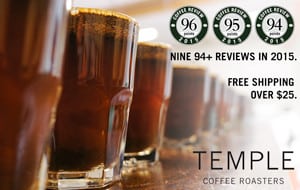Suppose you are in a traditional specialty coffee store examining the beans in the glass-fronted bins. Some, you notice, are darker in color than others. You may also note that most names given these darker coffees are European: French, Italian, Viennese, Continental. These names do not refer to the origin of the beans. Rather, they refer to degree of roast, or how far along the beans have been brought from green to light brown to medium brown to dark brown to almost black. Something called an Italian roast, for example, usually is darker in color and has been carried deeper into the roast spectrum than something called a Viennese roast. If a dark-roasted coffee comes from a single origin it usually is given a double label such as Dark-Roast Colombia or Italian-Roast Mexican. In other cases, however, dark roast coffees are a blend of beans from a variety of origins, in which case the name refers only to the roast, not to the origin of the bean.
The World's Leading Coffee Guide











